Last updated: July 22 2025
Quick vs. Detailed HST Reporting: What’s Right for Your Business?

Barbara Britto
Businesses registered for the GST and Harmonized Sales Tax (HST) in Canada must file returns and remit the tax they collect to the Canada Revenue Agency (CRA). When it comes to reporting the HST collected and the input tax credits (ITCs) they can claim, registrants have two primary options: the Quick method and the Detailed (or regular) method. Choosing the right method can significantly impact a business’s cash flow and administrative workload. This is just one aspect of strong tax advisory services, delivered to small businesses by a specialist. Consider earning the DMA- Corporate Tax Services Specialist Designation to gain deeper insights into tax planning & compliance to help clients make informed decisions—like choosing the right HST method. Here are some details about the HST filings:
The Detailed Method: Standard HST Reporting. The Detailed method is the traditional way of reporting HST. Under this approach, businesses:
- Charge and collect HST on taxable sales.
- Track all HST paid on eligible business expenses (known as input tax credits).
- File a return calculating the net tax by subtracting total ITCs from the total HST collected.
- Remit or receive the difference.
This method provides the maximum ITCs because it is calculated precisely, and is suitable for businesses that pay significant amounts of HST on expenses, allowing them to claim the full value of ITCs. However, it requires meticulous bookkeeping and detailed tracking of HST paid and collected. For many small businesses, this method can be time-consuming and burdensome unless they have an accounting system in place.
The Quick Method: Simplified Reporting. The Quick method is an alternative reporting option that simplifies the process of remitting HST. Instead of calculating the exact amount of HST collected and deducting input tax credits on every purchase, businesses using the Quick method:
- Continue to charge HST at the applicable rate (e.g., 13% in Ontario).
- Remit a reduced percentage of their gross (HST-inclusive) sales as their net tax owing. This percentage varies by industry and province.
The remittance rates in Ontario are:
- 4.4% for businesses that purchase goods for resale (e.g., antique dealers, convenience stores)

- 8.8% for businesses that provide services
In addition, CRA allows a 1% credit on the first $30,000 of eligible sales in a fiscal year.
Example: A service business in Ontario that charged $113,000 (including HST) for its services would remit 8.8% of that amount, or $9,944, minus the 1% credit on the first $30,000 ($300), resulting in a total HST remittance of $9,644.
This method reduces administrative work and may be financially beneficial for businesses with low input costs, since the remittance rate is often less than the full HST collected.
Who Is Eligible for the Quick Method? To use the Quick method, a business must meet all of the following criteria:
- Annual Worldwide Revenues:
The business (and its associates) must have less than $400,000 in worldwide taxable supplies (including zero-rated supplies but excluding financial services and sales of capital property) in the preceding fiscal year.
- Registrant Type:
Most businesses that provide goods and services are eligible, including sole proprietors, partnerships, and corporations.
- Business Type:
Certain types of businesses are excluded from using the Quick method, including:
- Accountants and bookkeepers
- Financial consultants
- Lawyers (except notaries in Quebec)
- Actuaries
- Audit services
- Listed financial institutions
- Charities and public service bodies
- Election Requirement:
Eligible businesses must elect to use the Quick method by filing Form GST74 (Election and Revocation of the Quick Method). The election generally takes effect at the beginning of a reporting period.
- Voluntary Revocation:
A business can stop using the Quick method by revoking the election. However, once revoked, it generally cannot re-elect to use the method for at least one year.
Which Method is Best? The best method depends on the nature and structure of the business. Consider the following:
Use the Quick method if:
- The business incurs relatively low input costs.
- Reducing the time and complexity of calculating ITCs is a priority.
- Annual revenues are under $400,000.
Use the Detailed method if:
- The business incurs significant HST on purchases and wants to maximize ITC claims.
- The business maintains detailed accounting records.
- The business is ineligible for the Quick method based on its professional classification.
Final Thoughts. Choosing between the Quick and Detailed method of HST reporting is more than an administrative decision—it can affect cash flow and profitability. While the Detailed method allows for precise calculations and full ITC claims, the Quick method offers a simpler approach that may be beneficial for service-based businesses with minimal expenses. Before making an election, consult a tax professional or accountant to determine which method best suits your business needs and eligibility.
Advance Your Skills in Tax Compliance
As a DMA-Corporate Tax Services Specialist, you’ll learn about corporate tax filing fundamentals and then help owner-managers who may include incorporated professionals plan compensation: salary, dividends, capital gains and bonuses. Assist with transition and succession planning pain points.
- Corporate Tax Filing Fundamentals
- Tax Planning for Corporate Owner-Managers
- Tax Planning for Incorporated Professionals
- Investment Tax Strategies
- Succession Planning for Owner-Managers
- Cross Border Taxation
“This program was very challenging and the information contained was valuable to me in my practice. I plan to keep my journal nearby as a reference when required. This is a very valuable program for anyone in private practice.”
- Heather McLeod, MFA - Business Services Specialist
